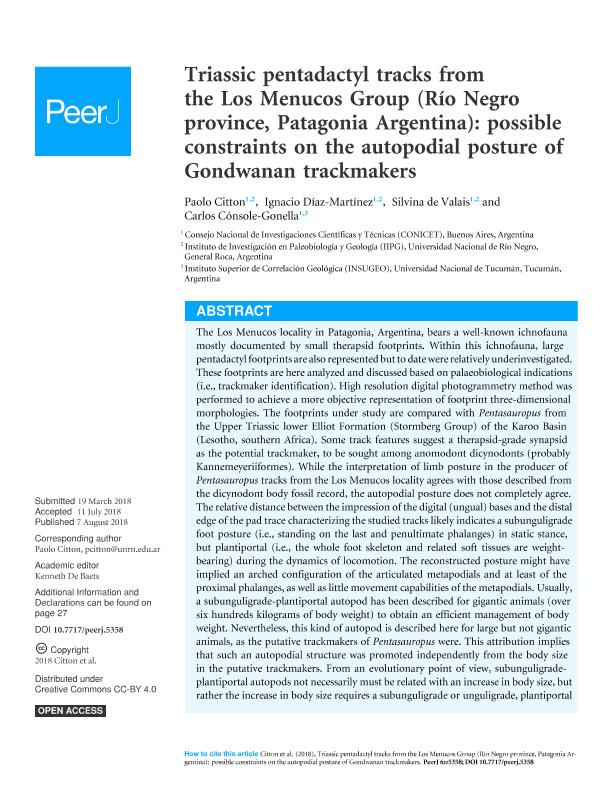Mostrar el registro sencillo del ítem
dc.contributor.author
Citton, Paolo

dc.contributor.author
Díaz Martínez, Ignacio

dc.contributor.author
de Valais, Silvina

dc.contributor.author
Cónsole Gonella, Carlos Alfredo

dc.date.available
2019-12-02T18:08:20Z
dc.date.issued
2018-08
dc.identifier.citation
Citton, Paolo; Díaz Martínez, Ignacio; de Valais, Silvina; Cónsole Gonella, Carlos Alfredo; Triassic pentadactyl tracks from the Los Menucos Group (Río Negro province, Patagonia Argentina): Possible constraints on the autopodial posture of Gondwanan trackmakers; PeerJ; PeerJ; 6; 8-2018; 1-36
dc.identifier.issn
2167-8359
dc.identifier.uri
http://hdl.handle.net/11336/91096
dc.description.abstract
The Los Menucos locality in Patagonia, Argentina, bears a well-known ichnofauna mostly documented by small therapsid footprints. Within this ichnofauna, large pentadactyl footprints are also represented but to date were relatively underinvestigated. These footprints are here analyzed and discussed based on palaeobiological indications (i.e., trackmaker identification). High resolution digital photogrammetry method was performed to achieve a more objective representation of footprint three-dimensional morphologies. The footprints under study are compared with Pentasauropus from the Upper Triassic lower Elliot Formation (Stormberg Group) of the Karoo Basin (Lesotho, southern Africa). Some track features suggest a therapsid-grade synapsid as the potential trackmaker, to be sought among anomodont dicynodonts (probably Kannemeyeriiformes). While the interpretation of limb posture in the producer of Pentasauropus tracks from the Los Menucos locality agrees with those described from the dicynodont body fossil record, the autopodial posture does not completely agree. The relative distance between the impression of the digital (ungual) bases and the distal edge of the pad trace characterizing the studied tracks likely indicates a subunguligrade foot posture (i.e., standing on the last and penultimate phalanges) in static stance, but plantiportal (i.e., the whole foot skeleton and related soft tissues are weightbearing) during the dynamics of locomotion. The reconstructed posture might have implied an arched configuration of the articulated metapodials and at least of the proximal phalanges, as well as little movement capabilities of the metapodials. Usually, a subunguligrade-plantiportal autopod has been described for gigantic animals (over six hundreds kilograms of body weight) to obtain an efficient management of body weight. Nevertheless, this kind of autopod is described here for large but not gigantic animals, as the putative trackmakers of Pentasauropus were. This attribution implies that such an autopodial structure was promoted independently from the body size in the putative trackmakers. From an evolutionary point of view, subunguligradeplantiportal autopods not necessarily must be related with an increase in body size, but rather the increase in body size requires a subunguligrade or unguligrade, plantiportal foot. Chronostratigraphically, Pentasauropus was reported from Upper Triassic deposits of South Africa and United States, and from late Middle Triassic and Upper Triassic deposits of Argentina. Based on the stratigraphic distribution of the ichnogenus currently accepted, a Late Triassic age is here proposed for the Pentasauropus-bearing levels of the Los Menucos Group.
dc.format
application/pdf
dc.language.iso
eng
dc.publisher
PeerJ
dc.rights
info:eu-repo/semantics/openAccess
dc.rights.uri
https://creativecommons.org/licenses/by/2.5/ar/
dc.subject
DICYNODONTS
dc.subject
GONDWANA
dc.subject
LOS MENUCOS
dc.subject
PATAGONIA
dc.subject
PENTASAUROPUS
dc.subject
THERAPSIDS
dc.subject
TRACKMAKERS
dc.subject
TRACKS
dc.subject
TRIASSIC
dc.subject.classification
Paleontología

dc.subject.classification
Ciencias de la Tierra y relacionadas con el Medio Ambiente

dc.subject.classification
CIENCIAS NATURALES Y EXACTAS

dc.title
Triassic pentadactyl tracks from the Los Menucos Group (Río Negro province, Patagonia Argentina): Possible constraints on the autopodial posture of Gondwanan trackmakers
dc.type
info:eu-repo/semantics/article
dc.type
info:ar-repo/semantics/artículo
dc.type
info:eu-repo/semantics/publishedVersion
dc.date.updated
2019-08-08T19:09:59Z
dc.journal.volume
6
dc.journal.pagination
1-36
dc.journal.pais
Reino Unido

dc.description.fil
Fil: Citton, Paolo. Consejo Nacional de Investigaciones Científicas y Técnicas. Centro Científico Tecnológico Conicet - Patagonia Norte. Instituto de Investigación en Paleobiología y Geología; Argentina
dc.description.fil
Fil: Díaz Martínez, Ignacio. Consejo Nacional de Investigaciones Científicas y Técnicas. Centro Científico Tecnológico Conicet - Patagonia Norte. Instituto de Investigación en Paleobiología y Geología; Argentina
dc.description.fil
Fil: de Valais, Silvina. Consejo Nacional de Investigaciones Científicas y Técnicas. Centro Científico Tecnológico Conicet - Patagonia Norte. Instituto de Investigación en Paleobiología y Geología; Argentina
dc.description.fil
Fil: Cónsole Gonella, Carlos Alfredo. Consejo Nacional de Investigaciones Científicas y Técnicas. Centro Científico Tecnológico Conicet - Tucumán. Instituto Superior de Correlación Geológica. Universidad Nacional de Tucumán. Facultad de Ciencias Naturales e Instituto Miguel Lillo. Departamento de Geología. Cátedra Geología Estructural. Instituto Superior de Correlación Geológica; Argentina
dc.journal.title
PeerJ
dc.relation.alternativeid
info:eu-repo/semantics/altIdentifier/url/https://peerj.com/articles/5358
dc.relation.alternativeid
info:eu-repo/semantics/altIdentifier/doi/http://dx.doi.org/10.7717/peerj.5358
Archivos asociados
